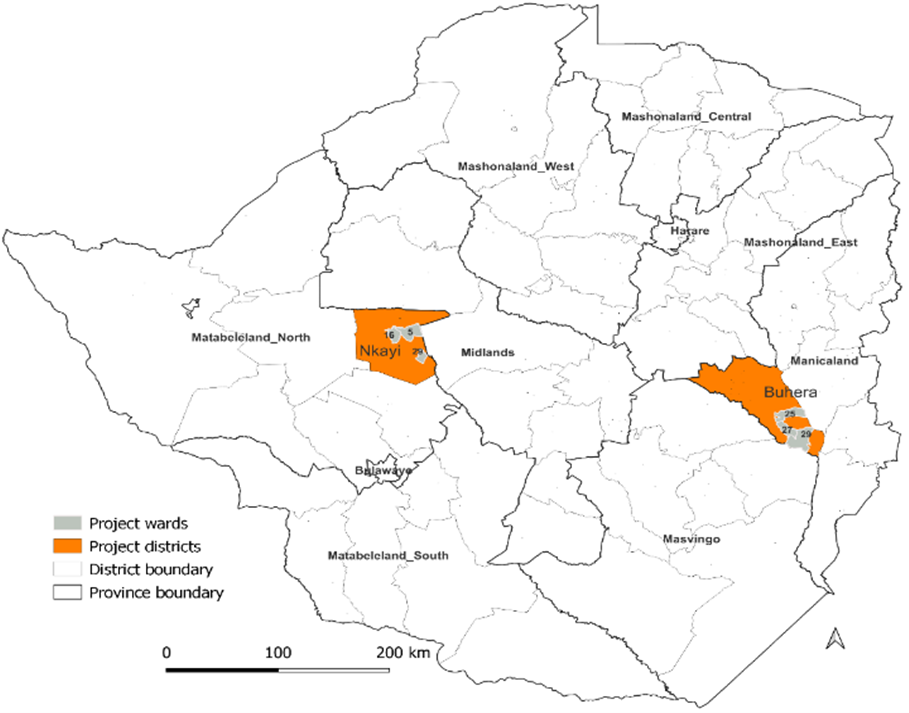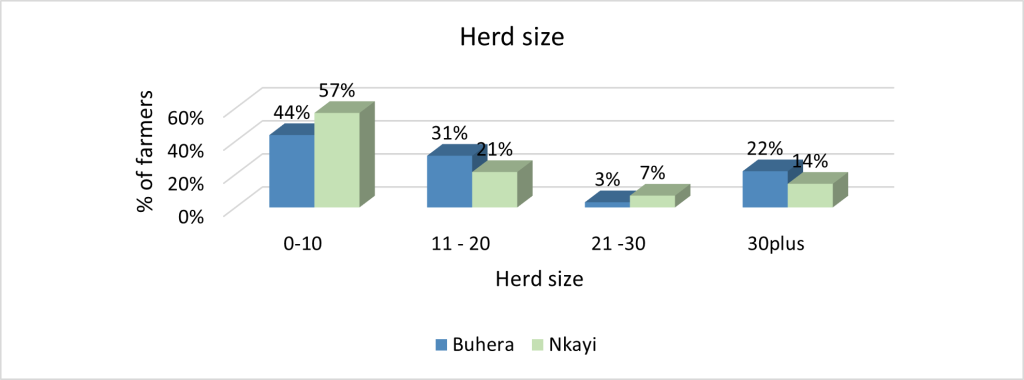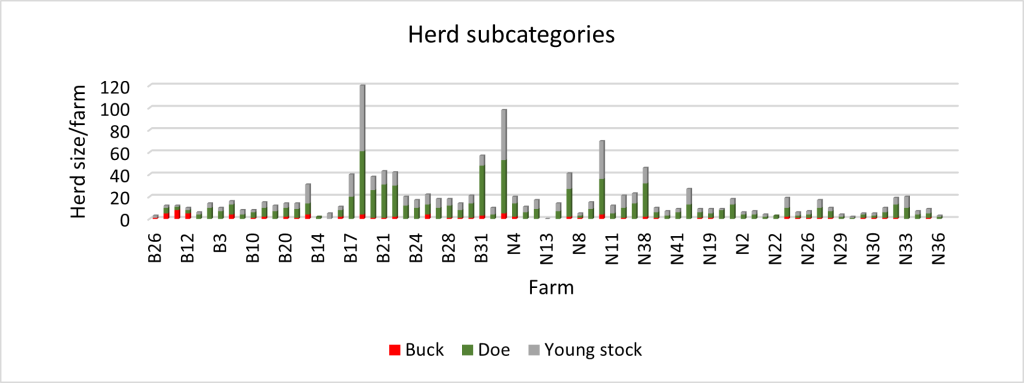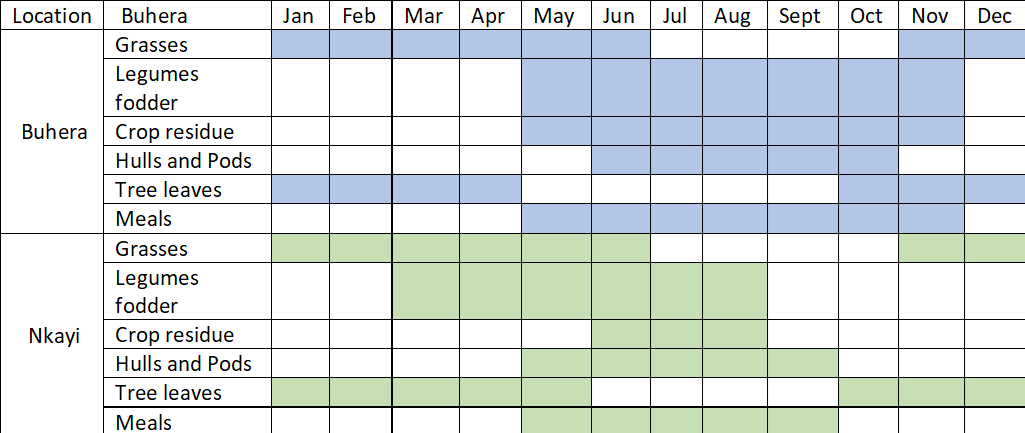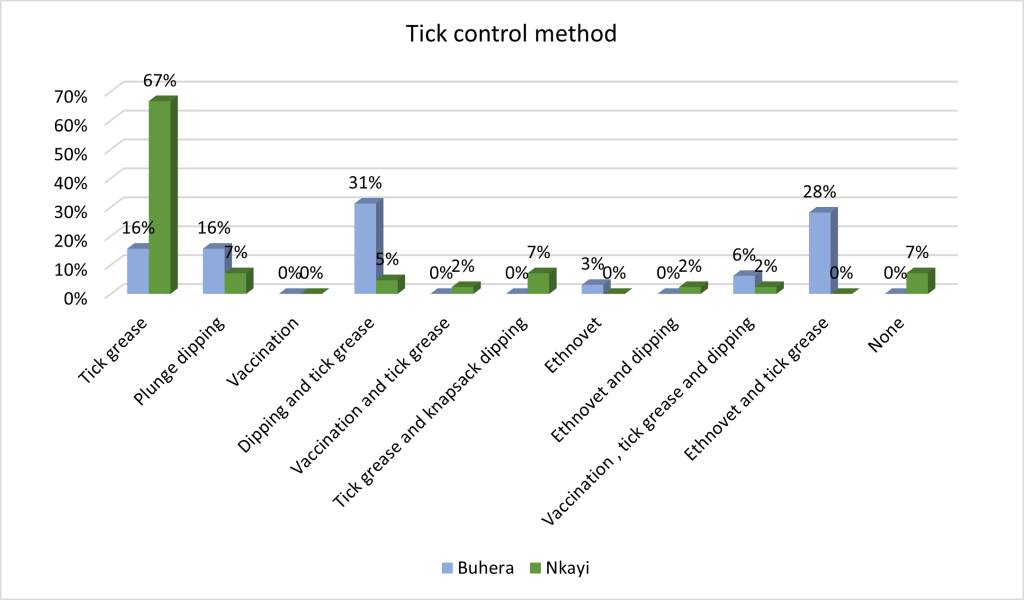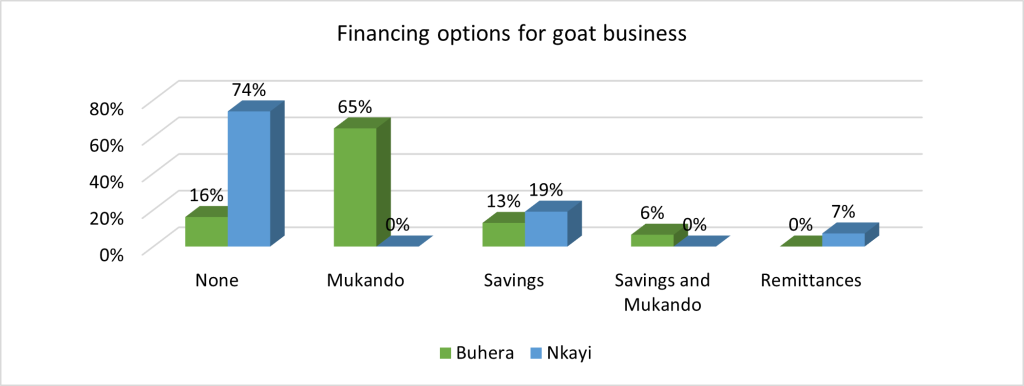Constraints and Opportunities in Extensive Goat Production Systems in Agroecological Region V of Buhera and Nkayi Districts of Zimbabwe
- Blessing Gumindoga
- Nyaradzai Ruponga
- Liana-Lisa Sakwa
- 395-404
- Jun 15, 2024
- Biotechnology
Constraints and Opportunities in Extensive Goat Production Systems in Agroecological Region V of Buhera and Nkayi Districts of Zimbabwe
Blessing Gumindoga1*, Nyaradzai Ruponga2, Liana-Lisa Sakwa3
1Research scientist Biotechnology research institute at SIRDC 1574, Alpes Road Scam Way, Harare
2Research scientist Geo-Information & Remote Sensing Institute at SIRDC
3Research scientist Biotechnology research institute
*Corresponding Author
DOI : https://doi.org/10.51584/IJRIAS.2024.905034
Received: 02 May 2024; Accepted: 14 May 2024; Published: 15 June 2024
ABSTRACT
This study aimed to assess the opportunities and constraints within the extensive goat production system of Zimbabwe. This was carried out using a literature review, key informant interviews and a household questionnaire. The low-quality feeds and limited supply coupled with low management levels and high disease prevalence contribute to low productivity and herd growth as observed by the small herd sizes of 44% in Buhera and 57% in Nkayi having less than 10 goats. The low buck ownership of 38% in Buhera and 53% in Nkayi contributes to the low conception rates. A total of 97% of farmers in Buhera and 33% in Nkayi offered crop residues as the main dry season supplementary feed with 41% in Nkayi not offering any form of supplementary feed, scaled adoption of forage legume was observed however the land allocated to forage production average 0.1ha resulting in insufficient quantities of feed being produced to cover dry season supplementary feed requirements. Low adoption of disease prevention practices such as dipping with 7% of farmers in Nkayi and none in Buhera and vaccination against tickborne diseases was observed in both sites. Drought was one of the other issues noted, scoring a high 20 in Buhera and 16 in Nkayi overall, which had a major impact on the goats’ limited access to feed and water. In Zimbabwe’s agroecological zone V, the implementation of climate-smart practices presents the potential to improve resilience, productivity, and mitigation of climate change in extensive goat production systems in agroecological zone V of Zimbabwe.
Keywords: Goat, feeds, diseases, adaptation, mitigation, productivity
INTRODUCTION
Goats play an important role in smallholder communities with over 97% of goat population in Zimbabwe being reared by smallholder farmers (Ndlovu et al., 2020). Goats have a significant role in communities in agroecological zone V which include nutrition, income generation, store of wealth, traditional functions and a source of manure. As a result of the high incidence of crop failure due to harsh temperatures, low rainfall and erratic rainfall patterns and high incidence of drought (Brazier, 2015) which have been exacerbated by climate change, goat are used to bridge both nutrition directly through household consumption and indirectly through income generation which then used to purchase other food as and when necessary. As such, these communities often suffer from food, nutrition and income insecurity. Goats are more adapted to the harsh climatic environment due to their browsing feeding habit, and as such thrive better than livestock such as cattle that are larger stock and mostly grazers. As farmers adapt and move towards mitigation against climate change, goat production is more ideal form of livestock owing to their resilience to the impacts of climate change (Hristov et al., 2013). Within the integrated crop-livestock system, goats complement well with other sub-systems such as cattle production considering that they do not offer much competition for feed resources with cattle which are the more preferred form of wealth. The sale of small stock such as goats is a lot easier than large stock, therefore can be used to bridge income gaps all year round enabling the household to purchase other needed commodities such as grain, as and when necessary.
In a typical smallholder farmer household, goats have functions which include: improving household nutrition, income, provision of manure which is used to fertilize the fields, insurance and storage of wealth culminating in improving social status and financing emergency cash needs (Homann et al., 2007). These goats contribute to food security and can alleviate seasonal food variability and availability directly through milk and meat production and indirectly through proceeds earned from the sale of their products (Homann et al., 2007). Extensive goat business requires less start-up capital and is a lot easier to liquidate in the event there is a need to use money therefore, it is an opportunity for women and youths who usually have less access to income-generating opportunities as compared to men.
The goat production systems in smallholder communal areas have remained subsistence (Ndlovu et al., 2020) mostly carried out within an integrated crop-livestock system (Homann et al., 2007). Indigenous breeds such as the Mashona and Matabele goats form the majority of the breeds kept. There is no defined breeding method or season as bucks and does are herded together all year round. The lack of controlled breeding has resulted in goat breeds which can only be defined as non-descript owing to inbreeding which is characterized by reduced frame size and reduced meat output. These goats are free range depending on grazing annual grasses and browsing as the main feed sources (Dube et al., 2017, Homann et al., 2007) with little to no supplementary feed being offered (Musendo et al., 2022; Mukondwa et al., 2021). The goat productivity is low as a result of poor feed quality and supply is insufficient and inconsistent worsened by the recurrent droughts and erratic rainfall patterns. The high range land degradation and mismanagement have contributed to reduced feed supply and poor quality feed i.e. low crude protein and digestibility (Charambira et al., 2021) especially in the dry season consequently failing to meet the goat’s nutritional needs (Homann et al., 2007).
Other challenges experienced within the extensive goat production systems are limited access to supplementary feed, theft, high disease prevalence contributing to high mortality (Dube et al., 2017; Ndlovu et al., 2020), predation exacerbated by poor management and limited farmer capacity to invest in improved infrastructure (Dube et al., 2017; Chakoma & Chummun, 2019). Through various goat improvement projects, there has been a drive to improve goat production through breed improvement by introducing exotic bucks such as the Boer and the Kalahari breeds in some communities (Ndlovu et al., 2020) and addressing feed challenges through fodder production (Chari, 2021). However, due to high disease prevalence, low management and feed challenges, the introduction of exotic breeds has varying success rates with high mortality being reported. The common diseases affecting goats include pulpy kidney (enterotoxaemia), internal and external parasites and tick-borne diseases (Homann et al., 2007) hence the need for strategic disease prevention and control.
Goat marketing is hindered by underdeveloped markets, inadequate infrastructure lack of market information high transaction costs and low prices (Homann et al., 2007). The majority of goats are sold through informal channels which are less regulated posing a major risk of disease transmission and stock theft. Limited access to developed markets reduces the profitability of the goat business (Ndlovu et al., 2020) as farmers settle for low prices (Dube et al., 2017) by selling to unscrupulous middlemen and neighbours within their local communities.
As a result of the above-mentioned constraints, extensive goat production systems have not changed much. Their contribution to household needs has remained low. However, through improved husbandry practices that address the challenges identified, both goat productivity and quality can be improved. This research aims to review the constraints and opportunities that can enable the existing extensive goat production system into much more productive and entrepreneur-oriented systems.
METHODOLOGY
A baseline survey was carried out to develop an understanding of the existing goat production systems, opportunities and constraints, and determine the implications of current husbandry practices on the growth, productivity and profitability of the goat business. The baseline survey design had a mixed approach where both quantitative and qualitative data were collected. Data collection tools used include literature review, household surveys, focus group discussions, key informant interviews and observations. The key informants include the Agriculture Advisory and Rural Development Services (AARDS) extension officers, District Development Coordinators (DDC), Rural District Council (RDC), Department of Veterinary Service (DVS) technicians, councillors and lead farmers in existing goat projects. The baseline was carried out in two districts, Buhera and Nkayi and within each district, a total of 3 wards were included in the household survey. In Buhera wards 25, 27 and 29 and in Nkayi wards 5, 16 and 29 (Figure 1) were selected.
Figure 1: Project site map
These wards were purposefully selected such that they include one ward that has had a development agent-led goat project and two that have not had any goat project. Ward 27 in Buhera and Ward 5 in Nkayi had the Zimbabwe Agriculture Growth Program (ZAGP) goat improvement centres. The household questionnaire was administered to a total of 45 households per district. The prerequisite for inclusion was the fact the household should be involved in goat production. An equal representation of male and female-headed households was also considered.
Data Analysis
Data cleaning and analysis were done using the Statistical Package for the Social Sciences (SPSS) software. The baseline survey data was subjected to quantitative and qualitative statistical data analysis techniques.
RESULTS AND DISCUSSION
An extensive goat production system was identified in both districts with goats being kept for household consumption, source of manure, store of wealth and as a source of income. The breeds are mostly indigenous and non-descript breeds with small frames although farmers prefer exotic breeds with bigger frames and more meat output. In areas where farmers benefited from breed intervention including the introduction of exotic bucks for example the Boer goat, the indigenous-exotic crosses increased in frame size. In both sites, the herd sizes are small with 44% in Buhera and 57% in Nkayi having less than 10 goats (Figure 2). Ownership of goats is mainly by men although women and children can also own goats.
Figure 2: Herd size
Within the herd, the subcategories were bucks 8%, does 55% and young stock 37% in Buhera whilst in Nkayi the bucks constituted 5%, does 54% and young stock 41% respectively.
*B- Buhera N-Nkayi
Figure 3: Herd subcategories
At the farm level, 38% in Buhera and 53% in Nkayi do not own any buck (table 1). These farmers depend on other farmers’ bucks for breeding, and this may contribute to low conception rates and long kidding intervals as a result of missed heats. Consequently, this leads to reduced productivity and herd growth.
Table 1: Buck ownership
| District | No buck | One buck | Two bucks | Three bucks | Four bucks | Five bucks + |
| Buhera | 38% | 25% | 13% | 3% | 13% | 9% |
| Nkayi | 53% | 29% | 12% | 0% | 3% | 3% |
In Nkayi, farmers preferred not having a buck within the herd because bucks tend to go astray and at times end up in home gardens therefore causing conflict. Total of 13% In Buhera and Nkayi 12% of farmers had two bucks with one second buck being a backup just in case the other one falls sick or dies. However, there was no correlation between owning more than one buck to having a high number of does (Figure 4).
Figure 4: Buck to doe ratio
The feed resources in Buhera and Nkayi include crop residues, legume fodder, grasses and indigenous tree pods and leaves however, there is seasonality in supply therefore access is based on the availability of either of those food sources. A total of 97% of farmers in Buhera offered supplementary feed in the form of crop residues and legume fodder whilst only 3% offered crop residues only. In Nkayi a total of 33% offered crop residues only, 26% crop residue and legume fodder combined and 41% did not offer any form of supplementary feed. Where the farmers own both cattle and goats, cattle are prioritised and as such the crop residues are stockpiled mainly for cattle, however, goats also benefit although to a lesser extent.
Feed challenges are experienced in both districts (Table 2). The challenges are both in quantity and quality of feed, especially in the dry season resulting in livestock losing body condition. This contributes to a low kidding rate with the majority of the goats only kidding once a year, long age at first kidding, long kidding interval and low conception rate which was observed in both districts.
Table 2: Feed availability all year round
The adoption of fodder production is increasing with most farmers getting fodder seeds from the government input scheme and non-governmental organisations. The main fodder crops received include velvet beans, lab lab, cowpeas and sun hemp. The current fodder production levels are low with land allocated to fodder production ranging around 0.1 hectares per household which is too small to make a significant impact on goat productivity as the yield is insufficient to cover the dry season supplementary feed requirements. The other constraint restricting fodder production is the fact that farmers have small land holdings and as a result, they prioritise food crops for the household. The fodder production and conservation processes are labor intensive therefore demotivating farmers from scaling fodder production especially women who form the majority of the rural population and are already burdened by other domestic chores. Land preparation is carried out using the plough and hoes where farmers choose to use the Pfumvudza/Intwasa conservation method. The harvesting and baling processes are manual mainly carried out by women using knives which is laborious and slow since choppers and balers are not available.
In both districts, there are high goat mortalities, especially for the young stock. The high mortality is attributed to high disease prevalence, poor disease prevention and low management, poor nutrition and inadequate goat pens that expose goats to harsh weather conditions. Table 3 summarizes common diseases, high incidence periods and mortality rates experienced. Another non-disease-related factor contributing to high mortality is predation, which is common during grazing time. To minimize goat predation when penned farmers strategically site goat pens close to the homestead or within the cattle pen and construct secure pens that prevent the entry of predators.
Table 3: Diseases and estimated mortality rates
| Buhera | Nkayi | |||
| Disease | Period of the year | Mortality rate | Period of the year | Mortality rate |
| Pulpy
Kidney |
-Rain season for adult goats and kids affected all year round
-Change of season |
60% | -Affects kids all year round
-change of season |
70% |
| Orf | -Onset of rains
November-March |
-No mortality goats just lose condition | -Onset of rains
December-March |
-No mortality goats just lose condition |
| Heart
Water |
Rain season
November-March |
20-30% | February-April | 25-33% |
| Liver
Fluke |
January-December | 25% | January-December | 25% |
| Footrot | November-March | Animals lose condition | Rain season | Rare |
| Diarrhea | All year round | 20-30% | All year round | 10-20% |
| Pneumonia | May-July | 10-15% | Rain season | 60% |
| Gall sickness | November to March | 15-30% | January- April | 20% |
| Naval ill | January –July | 6% | Affects kids just after birth | 15% |
| Hardware
Disease |
All year round | Rare | During droughts and around urban areas | 4% |
Goat dipping is very important in preventing tick-borne diseases; however, it is practised by very few farmers with 7% of farmers in Nkayi and none in Buhera thinking there is no need to dip goats yet they dip their cattle. Other challenges contributing to low dipping include the fact that there are no specialized goat dip tanks in most of the wards, and in areas where the tanks are available, they are located far away. Only one ward out of the three sampled wards had specialized plunge goat dip tanks located at the Zimbabwe Agriculture Growth Project goat improvement centres. Other farmers control ticks through measures such as spraying Buhera 16% and Nkayi 67% tick grease, dipping and tick grease 31% in Buhera and 5% In Nkayi. In both site sole use of vaccinations was not observed (Figure 5). These tick control measures are sometimes used in combination, for example, 2% of farmers in Nkayi combine the use of dipping and ethno-vet remedies or alternate.
Figure 5: Tick control methods
Allocation of tick grease by the Government of Zimbabwe to complement the dipping program is ongoing in both districts. In the initial stages, the tick grease targeted cattle that were being affected by Theileria (January disease). As a result, the issuing of tick grease was done using the cattle stock card. Therefore, farmers who don’t have cattle normally don’t have stock cards for goats, therefore, cannot access the tick grease. This has led to the mentality that tick grease is only for cattle. This may be a weak link in tick control especially for ticks that have a multiple host lifecycle.
Access to finance and other inputs is a challenge for rural farmers hence challenges in financing productivity improving interventions. This is sometimes addressed through the establishment of farmer groups to improve access to resources, sharing costs and also giving them bargaining power. The farmer group system was more common in Buhera with 84% of farmers and 21% in Nkayi belonging to a farmer group. These groups were mostly rotating savings and credit associations (locally known as Mukando) with benefits including access to credit with no interest (for members) and pooling of funds. In both districts, the contribution of savings is 13% Buhera and 19% Nkayi, and remittance is quite low although in Buhera 65% of farmers and none in Nkayi use Mukando to save or pool resources (none in Buhera and 7% in Nkayi) (Figure 6). As a result, the farmers have limited capacity to invest in productivity-oriented interventions hence the herd have remained small and the production system has remained with low input and low output. The farmer groups identified did not play any role in reducing transaction costs, bargaining power access to markets and sharing costs for example farmers can buy vaccines in groups and share costs considering the small herd size.
Figure 6: Financing options for goat business
The goat production system is affected by challenges including climate-related hazards such as drought, high temperature and erratic rain patterns which culminate in the form of water and feed shortages. These were observed in both sites however, there were differences in farmer ranking of these challenges. Drought, erratic rain season and water shortages were ranked very high with a total score of 20 in Buhera and 16 in Nkayi. Other challenges experienced include theft and predation, pests and diseases in Nkayi and Buhera (Table 5). Despite both regions being in the same agroecological zone huge differences were observed in the scoring of fire occurrence which were observed in Nkayi with a low score of 4 only and pest and diseased (score 16) and predators had a score of 12. In Buhera pests and diseases had a score of 9 and predators had a score of 3. Theft was also high in Nkayi with an overall score of 9 and in Buhera the overall score was much lower with a score of 4. Nkayi had more challenges having high scores therefore presenting more challenges for goat farmers to improve goat productivity.
Table 5: Challenges Affecting Goat Production
| Buhera | Nkayi | |||||
| Hazards | Probability of occurrence | Severity of impact | Overall score | Probability of occurrence | Severity of impact | Overall score |
| Scale 1-5 | Scale 1-5 | |||||
| Drought | 5 | 4 | 20 | 4 | 4 | 16 |
| High temperature /heatwaves | 2 | 2 | 4 | 2 | 1 | 2 |
| Fires | N/a | 2 | 2 | 4 | ||
| Erratic rain season | 4 | 5 | 20 | 4 | 4 | 16 |
| Pest and disease outbreaks | 3 | 3 | 9 | 4 | 4 | 16 |
| Predators | 1 | 3 | 3 | 3 | 4 | 12 |
| Water shortage | 4 | 4 | 16 | 5 | 4 | 20 |
| Theft | 2 | 2 | 4 | 3 | 3 | 9 |
Probability of occurrence scoring scale 1-5, 1 being lowest and 5 being highest
Severity of impact scoring scale 1-5, 1 being lowest and 5 being highest
Overall hazard score is a result of the probability of occurrence * Overall score. The higher the score the higher the ranking
With the forecasted increase in severity and occurrence of climate-related hazards, there is a need for upscaled adoption of climate adaptation and mitigation practices to enhance the resilience of the goat production system. The adaptation and coping strategies identified are mostly reactionary therefore, there is a need for the adoption of long-term strategies to reduce impact through improved preparedness, and the adoption of mitigation interventions such that the extensive goat production system can be more productive and resilient.
The main challenges identified include feed challenges, high disease prevalence and reduced access to finance and markets, which are contributing to low productivity in extensive goat production systems. This has reduced the contribution of goats to household nutrition, income and food security to households as a result of low offtakes. With the effects of climate change expected to increase in both occurrence and intensity, the productivity of goats is likely to continue to decrease as a result of increased feed challenges, incidences of diseases and high mortalities. The identified interventions are biased towards climate change adaptation as compared to climate change mitigation. Climate change mitigation is an indirect benefit of productivity-oriented and climate change adaptation interventions. An unintended effect of productivity-focused and climate change adaptation initiatives is the reduction of climate change. Using climate-smart methods can help goats contribute more to households and communities by increasing productivity, lowering greenhouse gas emissions, and promoting climate adaptation and mitigation. There is potential for lower greenhouse gas emission intensities from goat products with greater quantities being produced, as well as for the household to gain more economically and socially from the goat business.
This research has been carried out as part of the Livestock Production system in Zimbabwe (LIPS-Zim) titled “Promoting the Adoption of Sustainable Goat Business Models and Improved Fodder Production Through the Promotion of Gender Sensitive Fodder Production Equipment” implemented by Scientific and Industrial Research and Development Centre (SIRDC).
REFERENCES
- Brazier, A. (2015). Climate Change in Zimbabwe, Facts for planners and decision-makers. In Konrad Adenauer Drifting 26 Sandringham Drive, Alexandra Park, Harare, Zimbabwe.
- Chakoma, I., & Chummun, B. Z. (2019). Forage seed value chain analysis in a subhumid region of Zimbabwe: perspectives of smallholder producers. African Journal of Range and Forage Science, 36(2), 95–104. https://doi.org/10.2989/10220119.2018.1546229
- Charambira, T., Kagande, S. M., Chakoma, I., Chibaira, G., & Mugabe, P. H. (2021). Goat feeds and feeding practises in a semi-arid smallholder farming system in Zimbabwe. African Journal of Range and Forage Science, 38(S1), S90–S93. https://doi.org/10.2989/10220119.2021.1981444
- Dube, S., Chakoma, I., & Bahta, S. T. (2017). Analysis of the goat value chain in Beitbridge district of Zimbabwe. ILRI Project Report. https://cgspace.cgiar.org/bitstream/handle/10568/89915/ZimbabweVC_PR.pdf?sequenc
- Gerber, P., Vellinga, T., Opio, C., & Steinfeld, H. (2011). Productivity gains and greenhouse gas emissions intensity in dairy systems. Livestock Science, 139(1–2), 100–108. https://doi.org/10.1016/j.livsci.2011.03.012
- Goats, T. (2021). Value news. 4, 1–8.
- Homann, S., Rooyen, A. van, Moyo, T., & Nengomasha, Z. (2007). Goat production and marketing : Baseline information for Semi-arid Zimbabwe. International Crops Research Institute for the Semi-Arid Tropics., 1–71.
- Hristov, A. N., Oh, J., Lee, C., Meinen, R., Montes, F., Ott, T., Firkins, J., Rotz, A., Dell, C., Adesogan, A., Yang, W., Tricarico, J., Kebreab, E., Waghorn, G., Kijstra, J., & Oostin, S. (2013). Mitigation of greenhouse gas emissions in livestock production – A review of technical options for non-CO2 emissions (B. Pierre J. Gerber & H. and H. P. S. Makkar (eds.); Issue Paper No. 177. FAO). FAO Animal Production and Health Paper No. 177.
- Mukondwa, O., Moyo, M. T., Dlamini, T., & Mlilo, T. (2021). Characterization of the livestock production system and potential for enhancing productivity in Tohwe Nkayi (p. 10). IFCN.
- Musendo, B., Mubonani, R. L., Pfekenye, D., Taderera, L., & Mafukidze, P. (2022). Characterizing the livestock production systems and the potential for improving productivity in Ward 7 ( Mombeyara ), Buhera. July.
- Ndlovu, C., Rachel, M., Obert, W., & Abigirl, N. (2020). Breeding of goats: An indigenous approach to enhancing opportunities for smallholder farmers in Inyathi, Zimbabwe. International Journal of Livestock Production, 11(3), 91–101. https://doi.org/10.5897/ijlp2019.0586

